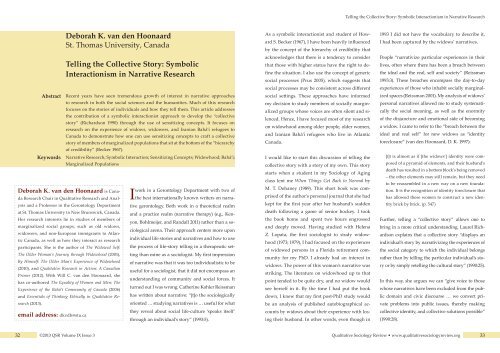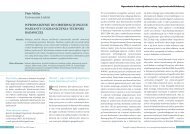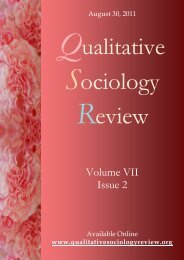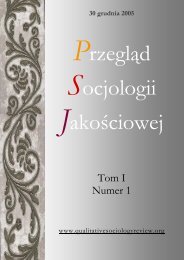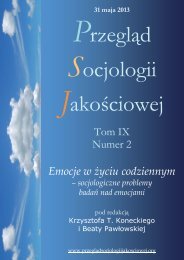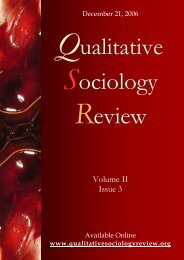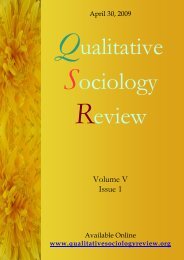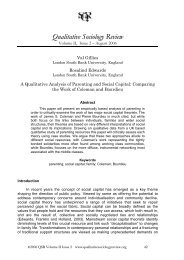Deborah K. van den Hoonaard St. Thomas University, Canada ...
Deborah K. van den Hoonaard St. Thomas University, Canada ...
Deborah K. van den Hoonaard St. Thomas University, Canada ...
Create successful ePaper yourself
Turn your PDF publications into a flip-book with our unique Google optimized e-Paper software.
Telling the Collective <strong>St</strong>ory: Symbolic Interactionism in Narrative Research<br />
Abstract<br />
Keywords<br />
<strong>Deborah</strong> K. <strong>van</strong> <strong>den</strong> <strong>Hoonaard</strong><br />
<strong>St</strong>. <strong>Thomas</strong> <strong>University</strong>, <strong>Canada</strong><br />
Telling the Collective <strong>St</strong>ory: Symbolic<br />
Interactionism in Narrative Research<br />
Recent years have seen tremendous growth of interest in narrative approaches<br />
to research in both the social sciences and the humanities. Much of this research<br />
focuses on the stories of individuals and how they tell them. This article addresses<br />
the contribution of a symbolic interactionist approach to develop the “collective<br />
story” (Richardson 1990) through the use of sensitizing concepts. It focuses on<br />
research on the experience of widows, widowers, and Iranian Bahá’í refugees to<br />
<strong>Canada</strong> to demonstrate how one can use sensitizing concepts to craft a collective<br />
story of members of marginalized populations that sit at the bottom of the “hierarchy<br />
of credibility” (Becker 1967).<br />
Narrative Research; Symbolic Interaction; Sensitizing Concepts; Widowhood; Bahá’í;<br />
Marginalized Populations<br />
<strong>Deborah</strong> K. <strong>van</strong> <strong>den</strong> <strong>Hoonaard</strong> is <strong>Canada</strong><br />
Research Chair in Qualitative Research and Analysis<br />
and a Professor in the Gerontology Department<br />
at <strong>St</strong>. <strong>Thomas</strong> <strong>University</strong> in New Brunswick, <strong>Canada</strong>.<br />
Her research interests lie in studies of members of<br />
marginalized social groups, such as old widows,<br />
widowers, and non-European immigrants to Atlantic<br />
<strong>Canada</strong>, as well as how they interact as research<br />
participants. She is the author of The Widowed Self:<br />
The Older Woman’s Journey through Widowhood (2001),<br />
By Himself: The Older Man’s Experience of Widowhood<br />
(2010), and Qualitative Research in Action: A Canadian<br />
Primer (2012). With Will C. <strong>van</strong> <strong>den</strong> <strong>Hoonaard</strong>, she<br />
has co-authored The Equality of Women and Men: The<br />
Experience of the Bahá’í Community of <strong>Canada</strong> (2006)<br />
and Essentials of Thinking Ethically in Qualitative Research<br />
(2013).<br />
email address: dkvdh@stu.ca<br />
I<br />
work in a Gerontology Department with two of<br />
the best internationally known writers on narrative<br />
gerontology. Both work in a theoretical realm<br />
and a practice realm (narrative therapy) (e.g., Kenyon,<br />
Bohlmeijer, and Randall 2011) rather than a sociological<br />
arena. Their approach centers more upon<br />
individual life stories and narratives and how to use<br />
the process of life-story telling in a therapeutic setting<br />
than mine as a sociologist. My first impression<br />
of narrative was that it was too individualistic to be<br />
useful for a sociologist, that it did not encompass an<br />
understanding of community and social forces. It<br />
turned out I was wrong. Catherine Kohler Reissman<br />
has written about narrative: “[t]o the sociologically<br />
oriented … studying narratives is … useful for what<br />
they reveal about social life-culture ‘speaks itself’<br />
through an individual’s story” (1993:5).<br />
As a symbolic interactionist and stu<strong>den</strong>t of Howard<br />
S. Becker (1967), I have been heavily influenced<br />
by the concept of the hierarchy of credibility that<br />
acknowledges that there is a ten<strong>den</strong>cy to consider<br />
that those with higher status have the right to define<br />
the situation. I also use the concept of generic<br />
social processes (Prus 2005), which suggests that<br />
social processes may be consistent across different<br />
social settings. These approaches have informed<br />
my decision to study members of socially marginalized<br />
groups whose voices are often silent and silenced.<br />
Hence, I have focused most of my research<br />
on widowhood among older people, older women,<br />
and Iranian Bahá’í refugees who live in Atlantic<br />
<strong>Canada</strong>.<br />
I would like to start this discussion of telling the<br />
collective story with a story of my own. This story<br />
starts when a stu<strong>den</strong>t in my Sociology of Aging<br />
class lent me When Things Get Back to Normal by<br />
M. T. Dohaney (1989). This short book was comprised<br />
of the author’s personal journal that she had<br />
kept for the first year after her husband’s sud<strong>den</strong><br />
death following a game of senior hockey. I took<br />
the book home and spent two hours engrossed<br />
and deeply moved. Having studied with Helena<br />
Z. Lopata, the first sociologist to study widowhood<br />
(1973; 1979), I had focused on the experiences<br />
of widowed persons in a Florida retirement community<br />
for my PhD. I already had an interest in<br />
widows. The power of this woman’s narrative was<br />
striking. The literature on widowhood up to that<br />
point tended to be quite dry, and no widow would<br />
see herself in it. By the time I had put the book<br />
down, I knew that my first post-PhD study would<br />
be an analysis of published autobiographical accounts<br />
by widows about their experience with losing<br />
their husband. In other words, even though in<br />
1993 I did not have the vocabulary to describe it,<br />
I had been captured by the widows’ narratives.<br />
People “narrativize particular experiences in their<br />
lives, often where there has been a breach between<br />
the ideal and the real, self and society” (Reissman<br />
1993:3). These breaches encompass the day-to-day<br />
experiences of those who inhabit socially marginalized<br />
spaces (Reissman 2001). My analysis of widows’<br />
personal narratives allowed me to study systematically<br />
the social meaning, as well as the enormity<br />
of the disjuncture and emotional side of becoming<br />
a widow. I came to refer to the “breach between the<br />
ideal and real self” for new widows as “i<strong>den</strong>tity<br />
foreclosure” (<strong>van</strong> <strong>den</strong> <strong>Hoonaard</strong>, D. K. 1997):<br />
[i]t is almost as if [the widows’] i<strong>den</strong>tity were composed<br />
of a pyramid of elements, and their husband’s<br />
death has resulted in a bottom block’s being removed<br />
– the other elements may still remain, but they need<br />
to be reassembled in a new way on a new foundation.<br />
It is the recognition of i<strong>den</strong>tity foreclosure that<br />
has allowed these women to construct a new i<strong>den</strong>tity<br />
brick by brick. (p. 547)<br />
Further, telling a “collective story” allows one to<br />
bring in a more critical understanding. Laurel Richardson<br />
explains that a collective story “displays an<br />
individual’s story by narrativizing the experiences of<br />
the social category to which the individual belongs<br />
rather than by telling the particular individual’s story<br />
or by simply retelling the cultural story” (1990:25).<br />
In this way, she argues we can “give voice to those<br />
whose narratives have been excluded from the public<br />
domain and civic discourse … we convert private<br />
problems into public issues, thereby making<br />
collective i<strong>den</strong>tity, and collective solutions possible”<br />
(1990:28).<br />
32<br />
©2013 QSR Volume IX Issue 3<br />
Qualitative Sociology Review • www.qualitativesociologyreview.org 33
<strong>Deborah</strong> K. <strong>van</strong> <strong>den</strong> <strong>Hoonaard</strong><br />
Telling the Collective <strong>St</strong>ory: Symbolic Interactionism in Narrative Research<br />
Since Laurel Richardson introduced the idea of collective<br />
stories, researchers across a variety of disci-<br />
ows, widowers, and Iranian Bahá’í refugees to Atlantic<br />
<strong>Canada</strong>.<br />
was only a word in the English language. Now it was<br />
me… (1989:6-7 as cited in <strong>van</strong> <strong>den</strong> <strong>Hoonaard</strong> 1997)<br />
friends, they have to “be fairly cheerful and upbeat”<br />
and not talk about their husbands too much:<br />
plines have used collective stories to communicate<br />
the experiences of individuals who inhabit a variety<br />
of social categories. Ayala Aylyn (2010) developed<br />
a collective story to communicate the experiences<br />
of individuals who had undergone trauma in<br />
their lives and who i<strong>den</strong>tified themselves as resilient.<br />
Richard Pringle (2008) used collective stories<br />
of men’s experience with a rugby union in New<br />
Zealand, where rugby is ubiquitous and dominates<br />
the formation of masculinities, as a pedagogical<br />
tool to communicate to his stu<strong>den</strong>ts the link between<br />
masculinities and rugby. Although Richardson<br />
conceived of the collective story to address the<br />
situation of people in socially marginal positions,<br />
Middleton, Anderson, and Banning (2009) developed<br />
a collective story of how members of socially<br />
dominant groups encountered and were transformed<br />
by recognizing their own privilege.<br />
Using the model of a collective story responds to<br />
Howard Becker’s classic question: “Whose side are<br />
we on?” (1967). We are on the side of those who<br />
belong to social categories that are marginalized or<br />
stigmatized in some way.<br />
One way to make collective stories meaningful is<br />
to i<strong>den</strong>tify sensitizing concepts within them. Sensitizing<br />
concepts are constructs “derived from the<br />
research participants’ perspective, use their language<br />
or expressions [that] sensitize the researcher<br />
to possible lines of inquiry” (<strong>van</strong> <strong>den</strong> <strong>Hoonaard</strong>,<br />
W. C. 1997:1). In other words, sensitizing concepts<br />
help researchers to understand their participants’<br />
worldview (<strong>van</strong> <strong>den</strong> <strong>Hoonaard</strong> 2012). The next sections<br />
explain a number of sensitizing concepts that<br />
I developed to write the collective stories of wid-<br />
Sensitizing Concepts in Widow’s<br />
Narratives<br />
In much of the literature on widows (even today)<br />
and in much of their portrayal in the public domain,<br />
widows are depicted as sad, lonely, and the victims<br />
of life’s problems. Their collective story recognizes<br />
the challenges they face but also depicts them as<br />
creative, resilient, and courageous. The following is<br />
a sample of the sensitizing concepts I “found” in my<br />
data and developed: “i<strong>den</strong>tifying moments,” “keeping<br />
up appearances,” “couples’ world,” “making<br />
do,” and “my children have their own lives.”<br />
I start with “i<strong>den</strong>tifying moments” because it is<br />
a sensitizing concept that I adopted from Kathy<br />
Charmaz’s work on chronic illness. She defines<br />
i<strong>den</strong>tifying moments as “telling moments filled<br />
with new self-images … telling because they spark<br />
sud<strong>den</strong> realizations [and] reveal hid<strong>den</strong> images of<br />
self” (1991:207). Having read Good Days, Bad Days,<br />
I immediately recognized the concept of i<strong>den</strong>tifying<br />
moments in the autobiographical accounts<br />
I read for my first study of widows. For example,<br />
M. T. Dohaney wrote in her journal:<br />
I was called a widow today. “Sign here” the girl in<br />
the office of vital statistics said when I went to pick<br />
up a copy of your death certificate … “Right here.<br />
In the block that says widow of the deceased.” The<br />
word pierced me like a lance and my sharp intake<br />
of breath was audible … Later, as I walked home,<br />
I tried to give voice to my new label. Widow! Widow!<br />
I mouthed the word over and over and although<br />
I could hear it thundering in my head, no sound<br />
would leave my lips … Until two weeks ago, widow<br />
In interviews with widows, the intensity of the i<strong>den</strong>tifying<br />
moment is a central part of the narrative:<br />
All of a sud<strong>den</strong> it occurred to me, “I am a widow.” Even<br />
though my mail may come to me as Mrs. ________,<br />
I am a widow… And it was like all of a sud<strong>den</strong> I realized<br />
it… It hadn’t occurred to me…at the time of<br />
death or at the funeral… Just all of a sud<strong>den</strong>, it hit me,<br />
“Hey, I am a widow.” (<strong>van</strong> <strong>den</strong> <strong>Hoonaard</strong> 2001:37) 1<br />
It hit me so hard, it almost turned me sick for the moment.<br />
Somebody said, “You’re a widow.” And, it almost<br />
made me feel sick to my stomach. That was the first<br />
time – I had never thought of myself as a widow. (p. 38)<br />
These stories of the discovery of a new i<strong>den</strong>tity,<br />
the i<strong>den</strong>tifying moment, carry a power in the telling<br />
that far exceeds a third-person description.<br />
Through the shock and sud<strong>den</strong> recognition described<br />
almost like being punched in the stomach,<br />
the story demonstrates that being a widow is an<br />
unwelcome i<strong>den</strong>tity that carries with it stigma and<br />
lower status. In fact, most widows say that they dislike<br />
the term. Even one of the reviewers of my article<br />
entitled “I<strong>den</strong>tity Foreclosure,” herself a widow,<br />
commented on her discomfort with the term.<br />
As all research has shown, when a woman becomes<br />
a widow, she loses many of her friends. The women<br />
I interviewed concurred. They also knew that they<br />
had lower status as single women and particular<br />
responsibilities, one of which was “keeping up appearances.”<br />
This sensitizing concept refers to widows’<br />
understanding that if they want to keep their<br />
1<br />
All quotations in this section, unless otherwise noted, are<br />
from <strong>van</strong> <strong>den</strong> <strong>Hoonaard</strong> (2001).<br />
Well, you’re going to go away from here thinking that<br />
I’m fine and I feel fine. Maybe you won’t be at the end<br />
of the road ‘til I’ll be weeping, but that’s all right. (p. 65)<br />
If I’d have wept and wailed and howled [in my<br />
friend’s] soup for the last six months…[my husband]<br />
would be very upset with me… Very disapproving…<br />
ashamed of me. (p. 64)<br />
Part of “keeping up appearances” is conforming to<br />
feeling rules by doing the emotion work (Hochschild<br />
1979) necessary to succeed:<br />
I just decided I have to pull myself together, you<br />
know, take the bull by the horns. I have always tried<br />
to be very cheerful about the whole thing. (<strong>van</strong> <strong>den</strong><br />
<strong>Hoonaard</strong> 2001:65)<br />
The way widows talk about the importance of<br />
keeping up appearances communicates their lower<br />
status. If they do not succeed, they will lose any<br />
friends who did not desert them at the start.<br />
A related sensitizing concept is “couples’ world”<br />
which refers to the widows’ feeling of not fitting<br />
into society in a comfortable way. When friends invite<br />
them out:<br />
And much as they say, “Well you’re welcome to come<br />
with us,” you always feel like the third person out. (p. 73)<br />
I know that there’s always going to be parties…that<br />
we used to go to that I’m not going to be included…<br />
I tell you, it’s a couples’ world. (p. 74)<br />
Another aspect of widows’ collective story relates<br />
to their relationship with money. For most, “making<br />
34<br />
©2013 QSR Volume IX Issue 3<br />
Qualitative Sociology Review • www.qualitativesociologyreview.org 35
<strong>Deborah</strong> K. <strong>van</strong> <strong>den</strong> <strong>Hoonaard</strong><br />
Telling the Collective <strong>St</strong>ory: Symbolic Interactionism in Narrative Research<br />
do” or “getting by” is the concept that captures<br />
how they interpret their financial situation either<br />
tive to their needs, their adult children have “their<br />
own lives.” These mothers need to make sure they<br />
be down to watch TV. And he watches the house…<br />
He checks to make sure everything’s all right. (p. 56)<br />
are central to the story highlight that they must<br />
“keep up appearances,” adapt to living as a single<br />
because they are “on a strict budget” or “don’t care<br />
about money” (p. 104). This sensitizing concept<br />
demonstrates older widows’ reluctance to appear to<br />
feel entitled to more than the minimal income many<br />
of them receive. They compare themselves favorably<br />
to women who do not know how to handle money<br />
through narratives of the inability to write a check 2 :<br />
Like I have a friend whose husband died sud<strong>den</strong>ly,<br />
she’d never written a check. She didn’t have a clue…<br />
and it was dreadful for her. She had no idea how<br />
much money there was available, where it was, and<br />
on top of having all the emotional things to deal<br />
with is really, really too much. (p.106)<br />
This situation of not being able to write a check<br />
came up in many of the stories women told about<br />
their friends or acquaintances even though they,<br />
themselves, knew how to write checks. It symbolized<br />
the relationship (or lack thereof) that women<br />
of their generation often had with money while<br />
they were married. The reference to not being able<br />
to write a check allowed the women to compare<br />
themselves positively to women who were not as<br />
well prepared. In fact, learning about finances while<br />
their husbands were still alive is the most common<br />
advice these widows had for other women.<br />
do not overstep an invisible boundary that would<br />
result in invading privacy, crowding, or expecting<br />
too much. Several women demonstrated much creativity<br />
in establishing a new relationship characterized<br />
by reciprocity.<br />
One story of a successful negotiations comes from<br />
one of the very few women who go south for the<br />
winter. She started by explaining:<br />
And my family, well, they’re just wonderful; they’re<br />
friends, as well as family. If I need anything, I only<br />
have to make a phone call. And if I don’t want them<br />
around, they don’t crowd me. (p. 55)<br />
In return, this woman feels comfortable calling on<br />
her children if there’s something she needs help<br />
with, but she usually tries to fix things herself. She<br />
told the story of installing window blinds. She put<br />
up one set of venetian blinds, which took her over<br />
an hour to accomplish. Her son came to visit, and<br />
she went into another room for just a few minutes,<br />
and when she returned, he said:<br />
“Your blind’s up.” He said, “I could have done that the<br />
first time, but I knew you wanted to do it.” So he let<br />
me try it. (p. 56)<br />
This widow’s story of her relationship with her<br />
children exemplifies successful negotiations of<br />
a reciprocal relationship that protects an older<br />
widow’s sense of herself as a competent adult and<br />
recognizes that her children have their own lives.<br />
Not all stories are of equal importance. Kenyon and<br />
Randall (1997:46-47) have developed the concept of<br />
“signature story,” a tale people like to tell about themselves<br />
or situations that they like to narrate. Similarly,<br />
a collective story may include a signature story. In the<br />
study of widows, the signature story communicates<br />
challenge, perseverance, and the development of<br />
a sense of competence and confi<strong>den</strong>ce, all of which<br />
characterize the accomplishments of widows and are<br />
a central part of their collective story:<br />
Well, there’s one thing, for instance, and it’s so simple…when<br />
the hydro goes out on the VCR and the<br />
clock…it’s blinking, twelve o’clock, twelve o’clock.<br />
I never, now this is so simple, I never adjusted that<br />
thing, and I just didn’t even know how to open this<br />
little box there… I left it for about…a week, blinking.<br />
Well, I put up a book so I wouldn’t see it… Yeah, I put<br />
a book up and said [to myself], “I don’t know how<br />
to do it.” So, one day, I went downstairs and I took<br />
my glasses and I said, “I’m going to fix this thing or<br />
woman in a “couples’ world,” find pride in “making<br />
do” with little money, and accept that their children<br />
“have their own lives.” Nonetheless, the collective<br />
story also reflects creativity, resilience, and strength<br />
that belie the stereotype of older widows as helpless.<br />
Sensitizing Concepts in Widowers’<br />
Narratives<br />
For older men who become widowed, the collective<br />
story is different. 3 One of the first questions people<br />
ask when they find out that I’ve studied both widows<br />
and widowers is whether women’s and men’s<br />
experiences are very different from one another.<br />
And how! When asked to describe in a very general<br />
way what it is like to become a widow, many<br />
women talked about how they met their husbands<br />
and what their marriages were like. They could<br />
not tell their story without including information<br />
about what was lost, as well as what had happened.<br />
In response to a similar question, men often talked<br />
about whether or not they wanted to get married<br />
again or observed that women are “after them” as<br />
widowers. 4 It is not surprising, then, that the sensitizing<br />
concepts that construct widowers’ collective<br />
story are different.<br />
The last sensitizing concept in the widows’ stories<br />
is “they have their own lives.” The women used<br />
this phrase to describe their place in their children’s<br />
lives. It recognizes that although most widows<br />
expect their children to be aware of and sensi-<br />
This same woman needed someone to pay her bills<br />
while she was in Florida and to keep an eye on her<br />
house in the winter. Her daughter pays her bills,<br />
and her son checks on her house. She developed<br />
a novel system of reciprocity:<br />
it’s going to be unplugged.” So, I sat down and I got<br />
the instructions out and I just went step by step and<br />
I thought this was a major, oh did a major job. Finally,<br />
I got it. And it was just the idea, I had never done it,<br />
and I had never even looked at the instructions. And<br />
a child, of course, could do it. But, it was a big achievement<br />
there. (<strong>van</strong> <strong>den</strong> <strong>Hoonaard</strong> 2012:123)<br />
The story, for men, revolves around the challenges<br />
widowhood presents to their i<strong>den</strong>tity as masculine,<br />
adult men. I had not expected to approach the widowers’<br />
collective story in terms of masculinity, but<br />
3<br />
Unless otherwise specified, all quotations in this section<br />
come from <strong>van</strong> <strong>den</strong> <strong>Hoonaard</strong> (2010).<br />
2<br />
The interviews took place in the mid 1990s. Today, widows<br />
would more likely talk about ATM’s or internet banking. I am<br />
currently doing a new study to see how the collective story of<br />
older widows has changed in the last 20 years.<br />
Yeah, well, my son is very fond of ice cream, and he<br />
can’t get cable [TV]…and he loves TV. So, I fill the<br />
freezer downstairs with ice cream, and I know he’ll<br />
The collective story of older widows makes visible<br />
their lower status, and the sensitizing concepts that<br />
4<br />
In fact, while I was working on the widower study, I was<br />
interviewed by Anne Kingston for an article she was writing<br />
about widowers for Maclean’s Magazine entitled: “The Sexiest<br />
Man Alive” (2007).<br />
36<br />
©2013 QSR Volume IX Issue 3<br />
Qualitative Sociology Review • www.qualitativesociologyreview.org 37
<strong>Deborah</strong> K. <strong>van</strong> <strong>den</strong> <strong>Hoonaard</strong><br />
Telling the Collective <strong>St</strong>ory: Symbolic Interactionism in Narrative Research<br />
the theme of being a real man was ubiquitous in the<br />
ready gotten the man. Alinde Moore and Dorothy<br />
I’ve played senior hockey; I’ve played senior basket-<br />
what was wrong, things simply progressed until<br />
data. Instead of looking at the men’s style of interaction<br />
as a problem, I used Holstein and Gubrium’s<br />
(1995) active-interview approach and used the interaction<br />
as data. I went back and listened to all the recordings<br />
again to be sure that then men were “doing<br />
gender” throughout the interviews. 5 The following<br />
<strong>St</strong>ratton (2002) report a similar phenomenon, the<br />
“casserole ladies” who also turn up in John Bayley’s<br />
book about his experience as a widower. Bayley,<br />
widower of author Iris Murdoch, opens his memoire<br />
with: “‘[n]ow, eat it while it’s nice and hot,’ ordered<br />
Margot, putting a lump of casserole on my plate”<br />
ball; I’ve played volleyball; I’ve played softball. Now,<br />
of course, I spent nine years coaching hockey at all<br />
the provincial levels; I coached baseball, you name it,<br />
and got involved with it, and I’d say, “Hey, come on<br />
home, I’ll cook you a steak.” So that to me was enjoyable,<br />
it still is enjoyable. (<strong>van</strong> <strong>den</strong> <strong>Hoonaard</strong> 2010:151)<br />
their wife died. They summarized this process as<br />
“downhill from there.” The inevitability of the final<br />
outcome stands out as a crucial aspect of the story.<br />
There is a similar lack of details in the stories the<br />
Atlantic Canadian widowers who were repartnered<br />
is a sample of the sensitizing concepts that emerged<br />
from an analysis of the data: “casserole brigade,”<br />
“nothing fancy,” “all downhill from there,” “one<br />
thing led to another,” and “getting out of the house.”<br />
The most obvious example is the “casserole brigade”<br />
which is comprised of single women who<br />
are lonely and seem almost predatory to the men<br />
in their attempts to attract a widower to a romantic<br />
relationship. This response came from a man who<br />
lived in a small town. He was replying to a question<br />
about whether or not anything had surprised him<br />
as a widower.<br />
Yes, about a month after my wife passed away. [The<br />
town I lived in]…is a small village of about 350 people,<br />
and I swear, 200 of them are widows – all living<br />
alone. So the “casserole brigade” started, and I hate<br />
casseroles. So, I had…a commercial freezer full of<br />
casseroles… And [they] would start pounding on the<br />
door. That kind of frightened me. (p. 95)<br />
In an earlier study, a widow who lived in a Florida<br />
retirement community remarked that if you showed<br />
up with a casserole while a widower is sitting shiva, 6<br />
it is too early. But, if you wait until shiva is over, you<br />
will be too late – some other woman will have al-<br />
5<br />
For an in-depth discussion of widowers’ strategies of selfrepresentation,<br />
see <strong>van</strong> <strong>den</strong> <strong>Hoonaard</strong> (2009).<br />
6<br />
During this week of confinement from routine duties, the<br />
widow or widower allows herself or himself to be cared for by<br />
family and close friends (Marcus 2004:216). At the end of the<br />
mourning period, the person rejoins society with the new status.<br />
(2001:3). Bayley (2001) writes about his own sense of<br />
being pursued by women as a “fantasy”:<br />
[t]here was really no need to feel threatened and disquieted.<br />
No doubt widowers’ weakness, as it might<br />
be called, was a well-known phenomenon in circles<br />
which widowers…frequented. They misunderstood<br />
the kindness women bestowed on them in their trouble.<br />
(p. 45-46)<br />
A telling counterpoint in this collective story is<br />
the reaction of the widowers to the question about<br />
whether they knew how to cook and clean before<br />
their wife died. The concept of “nothing fancy” characterizes<br />
their story. Most of the men explained that<br />
their cooking was quite simple; they did not know<br />
how to make casseroles or desserts. Here, the men<br />
used their story to distance themselves from women<br />
and their traditional tasks by claiming not to make<br />
the very kind of dish that women make when they<br />
are in pursuit of men as romantic partners.<br />
Men who could cook often listed masculine dishes,<br />
such as steak cooked on a George Foreman Grill,<br />
or associated their cooking with masculine activities.<br />
This man provided a list of sporting activities<br />
as part of his discussion about cooking. The story<br />
of cooking steak for other athletes is an important<br />
part of the story:<br />
I enjoyed cooking, enjoyed it, really. And yet, despite<br />
the fact, and I used to tell a lot of people, you know.<br />
The need to claim their masculinity was also evi<strong>den</strong>t<br />
in the way the widowers told the story of their<br />
wife’s death. Notably, the men appear as central actors<br />
in these narratives. These stories have a particular<br />
trajectory that includes: the woman’s hiding or<br />
downplaying symptoms, an initial misdiagnosis or<br />
minimizing of the ailment on the part of the doctor,<br />
a great deal of detail in the descriptions of the<br />
wife’s symptoms, and a truncated description of<br />
what happened after the diagnosis into the phrase<br />
“it was all downhill from there.”<br />
The men appear as central characters in the stories<br />
of what happened when their wife first became ill.<br />
For example, this man explained that the doctor initially<br />
thought his wife had an allergy. He recounted:<br />
After a time, I didn’t think so. And I had a conversation<br />
with the doctor… I told him why…because of what<br />
I said, he sent her for some X-rays. [Later when his wife<br />
had severe headaches] I thought it was connected because<br />
they’d found a spot on her lungs… I thought it has<br />
spread… So, I talked to the doctor about that. (p. 99)<br />
This type of agentic speech – in which the narrator<br />
portrays himself as an indepen<strong>den</strong>t actor (Kirsi,<br />
Hervonen, and Jylhä 2000) – characterized many of<br />
the stories the men told of their wife’s death (<strong>van</strong><br />
<strong>den</strong> <strong>Hoonaard</strong>, Bennett, and E<strong>van</strong>s 2012).<br />
In these widowers’ narratives, the terminal diagnosis<br />
was a singular moment in the story. Once they knew<br />
told about how they got together with their new wife<br />
or permanent girlfriend. In this situation, the sensitizing<br />
concept is “one thing led to another.” This man<br />
from Atlantic <strong>Canada</strong> told how he met his girlfriend:<br />
And there’s this lady next to me, and I asked her how<br />
long the boardwalk was… And she was kind of chatty,<br />
got talking to her…it sounded like her husband<br />
was something like my wife… So, one thing led to<br />
another. (p. 36)<br />
Compare his story to this American widower’s. In this<br />
story, he initially approached his “friend,” but then:<br />
After, she decided that she liked me… She came over<br />
a lot more than I realized. I didn’t mean to make<br />
a regular routine of it. I just asked her out once, and<br />
before I knew it, here she’s coming in like she’s my<br />
girlfriend… Actually, she pushed herself into it. (p. 98)<br />
As noted in the introduction, narratives often reflect<br />
the culture of the teller. This potential is realized<br />
in the widowers’ stories about developing relationships<br />
with women, which reflected strong cultural<br />
differences between Atlantic Canadians and bigcity,<br />
Jewish Americans. The Canadians’ stories have<br />
a fatalistic flavor captured in the concept, “one thing<br />
led to another.” The Jewish American stories also<br />
involve a lack of agency on the men’s part, but, in<br />
contrast, they emphasized their friend’s assertiveness<br />
in establishing a relationship. There were some<br />
assertive women in the Canadian widowers’ stories,<br />
38<br />
©2013 QSR Volume IX Issue 3<br />
Qualitative Sociology Review • www.qualitativesociologyreview.org 39
<strong>Deborah</strong> K. <strong>van</strong> <strong>den</strong> <strong>Hoonaard</strong><br />
Telling the Collective <strong>St</strong>ory: Symbolic Interactionism in Narrative Research<br />
but in these stories, the men rebuffed or were frightened<br />
by the women’s forwardness. These differences<br />
reflect very different, culturally-based definitions<br />
of the situation.<br />
For the widowers, getting out was also the alternative<br />
to wallowing in one’s misery. Hence, the<br />
mirror image of the concept of getting out is sitting<br />
around. The men equated staying home with<br />
sitting around, with giving up on life:<br />
reluctance to have too many commitments, freedom<br />
and indepen<strong>den</strong>ce are two things that they appreciate<br />
about being single. These quotes communicate<br />
the spontaneous nature of the men’s activities:<br />
stuff.” … And I said, “Well, does she owe you any<br />
money?” They wouldn’t tell me that either. So finally,<br />
I said to the girl, “Well, I hope she does… You’re going<br />
to have to find her to get it.” And I never heard from<br />
them about that. (p. 59)<br />
The last sensitizing concept in the widowers’ collective<br />
story is “getting out of the house.” The absence<br />
of their wife as a companion was a frequent<br />
theme, and being busy was a notable antidote for<br />
loneliness and being alone, which the widowers<br />
I’m not just sitting around the house, moping. It’s better<br />
to be busy than sitting around doing nothing, sitting<br />
around and thinking. Now, I don’t sit around,<br />
kind of, ”What am I going to do with myself?” (p. 127)<br />
We usually call one another up and “Meet you on the<br />
river,” or something like that. Usually ski up and down<br />
the river and go across the road there. Don’t have to<br />
drive anywhere. Just put on my skis and go. (p. 133)<br />
Like I say, the pool [in the retirement community] is<br />
This and other stories the men recounted have the<br />
theme of “winning” that is familiar in stories which<br />
portray a man as a “lone hero pitted against the<br />
odds” (Coates 2003:196).<br />
talked about as if they were synonymous. The<br />
solution for these widowers was “getting out of<br />
the house.” This sensitizing concept encompasses<br />
According to this widower, having nothing to do is<br />
equivalent to not getting out:<br />
a meeting place. You meet everybody there, eventually.<br />
So, if I want…people, I go down to the pool in the morning.<br />
If I want to be left alone, I just stay away. (p. 132)<br />
The collective story of older widowers illustrates<br />
the challenges around masculinity for older men.<br />
The sensitizing concepts that fill out the story<br />
how uncomfortable the men felt when they were<br />
alone in their house and the imperative to keep<br />
busy that is often seen as a panacea to life’s problems<br />
for older people (Ekerdt 1986).<br />
When the widowers’ wife died, the meaning of<br />
being at home changed. They found it challenging<br />
to spend time in their empty house. For example,<br />
one man told the story of the first time he<br />
entered his house after his wife’s death:<br />
From a home point of view, for the first few months<br />
after her death, and particularly the first time<br />
I opened the door. I looked in to see if she was playing<br />
Solitaire at the table…and she wasn’t there. And<br />
so, the house was like a big, empty cavern, canyon,<br />
cave, anything you want to express is. There was<br />
an emptiness there, and I was looking for her, and<br />
I couldn’t find her. And then, gradually, I accepted<br />
the fact… I got this storey and a half house all to<br />
myself, and I’ve got to live with it. (p. 126-127)<br />
This man’s alliterative description captures the<br />
discomfort of being home alone. The only solution<br />
is to “get out of the house.”<br />
[Were there any times that were more difficult than<br />
others?] [When] you’ve got nothing to do… Like an old<br />
dog, you go out [to] the road and look up and down the<br />
road and say, “Which way am I going to go today?”<br />
… Like I say, you just have to pick up and go somewhere…<br />
Just get in the truck, head for town. (p. 128)<br />
Put succinctly:<br />
I go out as frequently as I can… So, what I do is go out<br />
– get the hell out of the house. (p. 128)<br />
The importance of “getting out” is related to the<br />
men’s reluctance to have guests in their home. Their<br />
collective story of keeping socially connected by<br />
going out suggests that they are not likely to invite<br />
guests in:<br />
I rattle around this house like a pea in a box. I get out<br />
quite a lot. Try to mix and socialize. (p. 128)<br />
I like to have people around. I hate being alone. That’s<br />
why I’m gone all the time. (p. 129)<br />
“Getting out” is also a mechanism for informal and<br />
unplanned socializing. It reflects many widowers’<br />
Finally, community events provide opportunities<br />
for some widowers to maintain a full social life:<br />
I got to quite a few concerts… Meet friends there…<br />
I keep myself busy… Everybody asks me where the<br />
church suppers are for the weekend. So, I start looking<br />
about Wednesday…and I’ll go to a church supper<br />
on Saturday… And, you meet a lot of friends<br />
there… So, it almost got to the point where people<br />
go to the supper and say, “Oh, I wonder if Patrick<br />
will be here.” (p. 132)<br />
Just as there was a signature story for the collective<br />
story of widows, there is also one that communicates<br />
the challenge of older widowers to preserve<br />
their masculinity. This story involves a widower’s<br />
attempt to get customer loyalty points from<br />
two different stores:<br />
Like I went to [the store]; I knew she used to have<br />
[their] credit card. And she had [their customer-loyalty<br />
card]. So, I went in one day…to transfer her…points<br />
to my name. No way in hell. No, they wanted a copy<br />
of her will… They wanted her death certificate… So,<br />
that kind of ticked me off… They say, “Well, maybe<br />
you kicked her out, and you’re trying to take all her<br />
bring attention to areas that challenge widowers’<br />
masculinity, such as lack of control and developing<br />
new skills that were traditionally done by<br />
women. If there was one statement that sums up<br />
the men’s collective story, it is: “I was the man.”<br />
Iranian Bahá’í Refugees in Atlantic<br />
<strong>Canada</strong><br />
The last collective story is that of Iranian Bahá’í<br />
refugees who settled in Atlantic <strong>Canada</strong>. The<br />
Bahá’í faith originated in Persia (now Iran) in<br />
the mid-19 th century when a young man, the Báb,<br />
announced himself a prophet of God and the Harbinger<br />
of a Manifestation of God who would bring<br />
in a new era in human history. Baha’u’lláh proclaimed<br />
himself to be this messenger and spent<br />
the last 39 years of his life as a prisoner and exile. 7<br />
Bahá’ís have been persecuted in Iran since that time.<br />
After the Islamic Revolution of 1979, the persecution<br />
became a severe and systematic attempt to strangle<br />
the community.<br />
7<br />
Bahá’í social teachings include the unity of humanity, the<br />
equality of women and men, and the elimination of racial and<br />
other prejudices, among others.<br />
40<br />
©2013 QSR Volume IX Issue 3<br />
Qualitative Sociology Review • www.qualitativesociologyreview.org 41
<strong>Deborah</strong> K. <strong>van</strong> <strong>den</strong> <strong>Hoonaard</strong><br />
Telling the Collective <strong>St</strong>ory: Symbolic Interactionism in Narrative Research<br />
The Bahá’í community of <strong>Canada</strong> has existed for<br />
almost 100 years and has about 33,000 members.<br />
Many Bahá’í refugees arrived in <strong>Canada</strong> in the<br />
ting there…it was great. We stayed at his house for two<br />
months, and that is the time I felt that being a Bahá’í<br />
was the most incredible thing in life. (p. 4)<br />
The Bahá’í refugees used hospitality and creativity<br />
to address these issues:<br />
socially marginalized. In his book, Working with<br />
Sensitizing Concepts, Will <strong>van</strong> <strong>den</strong> <strong>Hoonaard</strong> (1997)<br />
says that sensitizing concepts move us toward<br />
1980s through a cooperative program between the<br />
Government of <strong>Canada</strong> and the National Bahá’í<br />
Community of <strong>Canada</strong>. Most of the Bahá’ís who<br />
came through that program now live in major urban<br />
centers, such as Vancouver and Toronto, but<br />
a small number have stayed in Atlantic <strong>Canada</strong>. It<br />
is the collective story of that small group, numbering<br />
about 200, that this article addresses.<br />
The sensitizing concepts that arose in the newcomers’<br />
stories are: “not knowing what to expect,”<br />
“being treated like family,” and “using creativity<br />
and hospitality to neutralize blame and overcome<br />
prejudice.”<br />
The story of settlement in <strong>Canada</strong> starts with the<br />
newcomers’ not knowing what to expect. They<br />
had no idea how rural Atlantic <strong>Canada</strong> is:<br />
Yeah, there were no tall buildings. When I came to<br />
<strong>Canada</strong>… I thought we were going to a place like<br />
New York…tall buildings, you know. And we flew<br />
into Halifax…nothing but trees. (p. 2) 8<br />
Nonetheless, even though they were unprepared<br />
for life in Atlantic <strong>Canada</strong>, the Canadian Bahá’ís<br />
welcomed them like family:<br />
And I remember, Mr. R. told me that, “You go [by train]<br />
and meet the gentleman called Bill.” And that was it.<br />
No last name… So, we were supposed to stay at their<br />
home… And, when we came to the train station, the<br />
train stopped…all the Bahá’ís were there… Very exciting<br />
time… And a few minutes later we were at Bill’s sit-<br />
8<br />
Unless otherwise noted, all quotations in this section are<br />
from <strong>van</strong> <strong>den</strong> <strong>Hoonaard</strong> and <strong>van</strong> <strong>den</strong> <strong>Hoonaard</strong> (2007).<br />
Like members of a family, I had no idea who they<br />
were and they didn’t have any idea who I was. But,<br />
they accepted me with open arms, and we became<br />
almost like a family, and being here twenty years…<br />
we still feel like a family. (p. 5)<br />
The warm reception from the local Bahá’ís was<br />
a contrast to the reception the Persian newcomers<br />
received from the broader community. The implicit<br />
prejudice they faced made it hard for them<br />
to find work or make friends other than Bahá’ís:<br />
It was really hard to get a job. And everybody was fearful,<br />
“Is this guy a good guy to work for me and is he<br />
going to be able to talk in a [way] that I can understand<br />
it? Is he going to drive my customers away?” You know,<br />
you’re either white, Canadian people or you were not<br />
part of them. So, it was kind of hard to break into. (p. 6)<br />
The newcomers chose to avoid taking the rebuffs<br />
personally:<br />
You know, it’s very obvious [that I was being passed<br />
over for promotion]… I don’t [take it] personally. If we<br />
do…we never improve ourselves. You know, don’t get<br />
personal… That is life, and I’ve never been Canadian,<br />
even after 100 years… I am [an] immigrant. You know,<br />
I have to accept that and do my job. (p. 8)<br />
They explain that, given the circumstances in the<br />
world, no one should be blamed for fearing strangers,<br />
especially dark-skinned ones:<br />
Not that I blame them because there are so many<br />
things going on in the Middle East that you don’t<br />
know, “Should I trust this guy or not?” (p. 8)<br />
They’re scared… But, we showed our love, we show<br />
all of it, we show all our love, and, “How are you?<br />
Good morning.” (p. 8)<br />
The collective story includes a combination of creativity<br />
and hospitality. Here is a signature story of<br />
Persian Bahá’í refugees in Atlantic <strong>Canada</strong>:<br />
[I heard from a neighbor that] “people think that<br />
you have a rifle in your basement, and you are<br />
waiting for some good opportunity to attack”<br />
… I said, “No [we don’t have such things], you<br />
can come and visit us.” Later on, they came over<br />
and, on purpose, I said, “Okay, I want to give you<br />
a tour of my house.” You know, let’s see the bedroom,<br />
and… I take them to the basement, and here<br />
is the laundry room, here is the workshop…just<br />
show them everything, and now they are very,<br />
very friendly. When they have any family problem<br />
they come over here, and they ask us to solve their<br />
problem. (p. 10)<br />
The collective story of the Iranian Bahá’í newcomers<br />
includes the persecution that drove them out of<br />
their homeland and tells how they were welcomed<br />
to their new homes, the barriers they faced, and<br />
their efforts to overcome those barriers. The sensitizing<br />
concepts provide an entry to understanding<br />
how these immigrants interpreted and dealt with<br />
their situation.<br />
Conclusion<br />
This article has focused on three studies to demonstrate<br />
how sensitizing concepts can assist us to<br />
construct the collective story of groups who are<br />
more abstract or general theorizing. This article<br />
suggests that they can also be the building blocks<br />
of a collective story.<br />
Laurel Richardson writes that although a collective<br />
story is about a category of people rather than<br />
individuals, “the individual response to a welltold<br />
collective story is, ‘That’s my story. I am not<br />
alone’” (1990:26). She argues that the collective<br />
story should be written in language that is accessible<br />
to members of the social category it involves<br />
(1988) as a means of constructing a “consciousness<br />
of kind…a concrete recognition of sociological<br />
bondedness [which can] break down isolation<br />
[and potentially] alter the system” (Richardson<br />
2000:336).<br />
It appears that the widows’ collective story, told in<br />
The Widowed Self (<strong>van</strong> <strong>den</strong> <strong>Hoonaard</strong> 2001), has met<br />
this standard. When an article about my new research<br />
on widowhood appeared in the local newspaper,<br />
one of the volunteers for the study said that<br />
she had read the book, found it very helpful, and<br />
wanted to be interviewed for the new study to help<br />
other widows.<br />
This article has demonstrated the usefulness<br />
of sensitizing concepts in the construction and<br />
telling of a collective story. Because sociologists<br />
develop these concepts inductively and use the<br />
language of research participants to name and<br />
formulate them, they have a unique potential to<br />
contribute to collective stories that are both powerful<br />
and accessible to scholars and members of<br />
categories whose story is being told.<br />
42<br />
©2013 QSR Volume IX Issue 3<br />
Qualitative Sociology Review • www.qualitativesociologyreview.org 43
<strong>Deborah</strong> K. <strong>van</strong> <strong>den</strong> <strong>Hoonaard</strong><br />
Telling the Collective <strong>St</strong>ory: Symbolic Interactionism in Narrative Research<br />
Acknowledgements<br />
A Meta-Narrative Approach.” Journal of Transformative<br />
Education 7:294-311.<br />
pressed in Autobiographical Accounts.” Ageing & Society<br />
17:533-551.<br />
The study of widows was funded by a Community<br />
Researcher Award from the Seniors’ Indepen<strong>den</strong>ce Research<br />
Program of Health <strong>Canada</strong> and a Grant to Small<br />
Universities from the Social Sciences and Humanities<br />
Research Council of <strong>Canada</strong>. The study of widowers<br />
was funded by a Social Sciences and Humanities<br />
Research Council <strong>St</strong>andard Research Grant, and the<br />
study of Iranian Bahá’í refugees was funded by grants<br />
from the New Brunswick and Atlantic <strong>St</strong>udies Research<br />
and Development Centre and Metropolis.<br />
Moore, Alinde J. and Dorothy C. <strong>St</strong>ratton. 2002. Resilient<br />
Widowers: Older Men Speak for Themselves. New York:<br />
Springer.<br />
Pringle, Richard. 2008. “No Rugby, no fear: Collective<br />
stories, masculinities, and transformative possibilities in<br />
schools.” Sports, Education & Society 13(2):215-237.<br />
<strong>van</strong> <strong>den</strong> <strong>Hoonaard</strong>, <strong>Deborah</strong>. K. 2001. The Widowed Self:<br />
The Older Woman’s Journey Through Widowhood. Waterloo,<br />
ON: Wilfrid Laurier <strong>University</strong> Press.<br />
<strong>van</strong> <strong>den</strong> <strong>Hoonaard</strong>, <strong>Deborah</strong>. K. 2009. “Widowers’ strategies<br />
of self-representation during research interviews:<br />
A sociological analysis.” Ageing & Society 29:257-276.<br />
References<br />
Aylyn, Ayalah. 2010. Resurrection Ferns: Resiliency, Art,<br />
and Meaning Constructs Among Survivors of Trauma or Difficult<br />
Life Events. PhD dissertation, <strong>University</strong> of Alberta.<br />
Bayley, John. 2001. Widower’s House: A <strong>St</strong>udy in Bereavement<br />
or How Margo and Mella Forced me to Flee My Home.<br />
New York: W. W. Norton & Company.<br />
Becker, Howard. 1967. “Whose Side are We on?” Social<br />
Kenyon, Gary, Ernst Bohlmeijer, and William L. Randall.<br />
2011. <strong>St</strong>orying Later Life: Issues, Investigations, and Interventions<br />
in Narrative Gerontology. New York: Oxford <strong>University</strong><br />
Press.<br />
Kenyon, Gary and William L. Randall. 1997. Restorying<br />
Our Lives: Personal Growth through Autobiographical Reflection.<br />
Westport, CN: Praeger.<br />
Prus, Robert. (2005) “<strong>St</strong>udying Human Knowing and<br />
Acting: The Interactional Quest for Authenticity.” Pp.<br />
7-13 in Doing Ethnography: <strong>St</strong>udying Everyday Life, edited<br />
by Dorothy Pawluch, William Shaffir, and Charlene Miall.<br />
Toronto: Canadian Scholars’ Press.<br />
Reissman, Catherine K. 1993. Narrative Analysis. Newbury<br />
Park, CA: Sage.<br />
Reissman, Catherine K. 2001. “Analysis of Personal Narratives.”<br />
Pp. 695-710 in Handbook of Interview Research:<br />
Context and Method, edited by Jaber F. Gubrium and<br />
James A. Holstein. Thousand Oaks, CA: Sage.<br />
Richardson, Laurel. 1988. “The Collective <strong>St</strong>ory: Postmodernism<br />
and the writing of sociology.” Sociological Focus<br />
21(3):199-208.<br />
<strong>van</strong> <strong>den</strong> <strong>Hoonaard</strong>, <strong>Deborah</strong>. K. 2010. By Himself: The<br />
Older Man’s Experience of Widowhood. Toronto: <strong>University</strong><br />
of Toronto Press.<br />
<strong>van</strong> <strong>den</strong> <strong>Hoonaard</strong>, <strong>Deborah</strong>. K. 2012. Qualitative Research<br />
in Action: A Canadian Primer. Toronto: Oxford <strong>University</strong><br />
Press.<br />
<strong>van</strong> <strong>den</strong> <strong>Hoonaard</strong>, <strong>Deborah</strong>. K., Kate M. Bennett, and<br />
Elizabeth E<strong>van</strong>s. 2012. “I was there when she passed:<br />
older widowers’ narratives of the death of their wife.”<br />
Ageing & Society / FirstView Article:1-18. Retrieved June<br />
20, 2013 (http://www.liv.ac.uk/~kmb/MyPublishedPapers/<strong>van</strong><strong>den</strong><strong>Hoonaard</strong>BennettE<strong>van</strong>s2013.pdf).<br />
<strong>van</strong> <strong>den</strong> <strong>Hoonaard</strong>, Will C. 1997. Working with Sensitizing<br />
Concepts: Analytical Field Research. Thousand Oaks, CA:<br />
Problems 14(3):239-247.<br />
Charmaz, Kathy. 1991. Good Days, Bad Days: the Self in<br />
Kingston, Anne. 2007. “The Sexiest Man Alive.” Maclean’s,<br />
November 22.<br />
Richardson, Laurel. 1990. Writing <strong>St</strong>rategies: Reach Diverse<br />
Audiences. Newbury Park, CA: Sage.<br />
Sage.<br />
<strong>van</strong> <strong>den</strong> <strong>Hoonaard</strong>, Will C. and <strong>Deborah</strong>. K. <strong>van</strong> <strong>den</strong><br />
Chronic Illness and Time. New Brunswick, NJ: Rutgers<br />
<strong>University</strong> Press.<br />
Coates, Jennifer. 2003. Men talk. <strong>St</strong>ories in the making of<br />
masculinities. Oxford: Blackwell Publishing.<br />
Dohaney, Myrtis. 1989. When Things Get Back to Normal.<br />
Porters Lake, NS: Pottersfield Press.<br />
Kirsi, Tapio, Antti Hervonen, and Marja Jylhä. 2000.<br />
“A Man’s Gotta Do What a Man’s Gotta Do: Husbands<br />
as Caregivers to their Demented Wives, A Discourse<br />
Analysis.” Journal of Aging <strong>St</strong>udies 14(2):153-169.<br />
Lopata, Helena Z. 1973. Widowhood in an American City.<br />
Cambridge, MA: Schenkman.<br />
Richardson, Laurel. 2000. “The Metaphor is the Message:<br />
Commentary on Arthur Frank’s ‘Illness and the Interactionist<br />
Vocation’.” Symbolic Interaction 23(4):333-336.<br />
<strong>van</strong> <strong>den</strong> <strong>Hoonaard</strong>, <strong>Deborah</strong>. K. 1997. “I<strong>den</strong>tity Foreclosure:<br />
Women’s Experiences of Widowhood as Ex-<br />
<strong>Hoonaard</strong>. 2007. “The Poignant Accomplishments of<br />
Bahá’í Newcomers from Iran.” Paper delivered at the<br />
New Brunswick and Atlantic <strong>St</strong>udies Research and Development<br />
Centre Conference: Town and Country: Exploring<br />
Urban and Rural Issues in New Brunswick. <strong>St</strong>. <strong>Thomas</strong><br />
<strong>University</strong>, June 22-23, Fredericton, <strong>Canada</strong>.<br />
Ekerdt, David. 1986. “The Busy Ethic: Moral Continuity Between<br />
Work and Retirement.” Gerontologist 26(3):239-244.<br />
Hochschild, Arlie. 1979. “Emotion Work, Feeling Rules,<br />
and Social <strong>St</strong>ructure.” American Journal of Sociology<br />
85(3):551-575.<br />
Holstein, James A. and Jaber F. Gubrium. 1995. The Active<br />
Interview. Thousand Oaks, CA: Sage.<br />
Lopata, Helena Z. 1979. Women as Widows: Support Systems.<br />
New York: Elsevier.<br />
Marcus, I<strong>van</strong> G. 2004. The Jewish Life Cycle: Rites of Passage<br />
from Biblical to Modern Times. Seattle: <strong>University</strong> of<br />
Washington Press.<br />
Middleton, Valerie A., Sharon K. Anderson, and James H.<br />
Banning. 2009. “The Journey to Understanding Privilege:<br />
<strong>van</strong> <strong>den</strong> <strong>Hoonaard</strong>, <strong>Deborah</strong> K. 2013. “Telling the Collective <strong>St</strong>ory: Symbolic Interactionism in Narrative<br />
Research.“ Qualitative Sociology Review 9(3):32-45. Retrieved Month, Year (http://www.qualitativesociologyreview.org/ENG/archive_eng.php).<br />
44<br />
©2013 QSR Volume IX Issue 3<br />
Qualitative Sociology Review • www.qualitativesociologyreview.org 45


